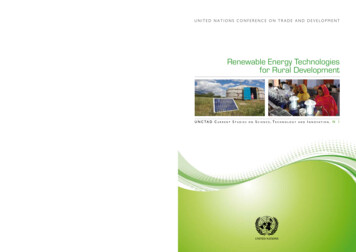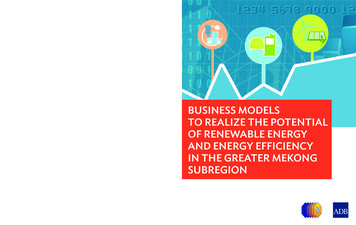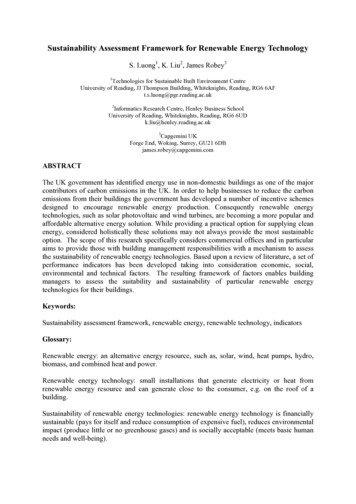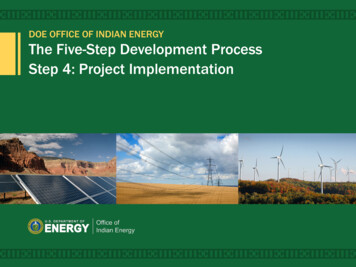
Transcription
United Nations Conference on Trade and DevelopmentRenewable Energy Technologiesfor Rural DevelopmentU N C T A D C u r r e nt S tud i e sonS c i e nc e , T e c h n o l o g yandI nn o v at i o n . N º 1
UNITED NATIONS CONFERENCE ON TRADE AND DEVELOPMENTUNCTAD CURRENT STUDIES ON SCIENCE, TECHNOLOGY AND INNOVATIONRenewable Energy Technologies forRural DevelopmentUNITED NATIONSNew York and Geneva, 2010
UNCTAD CURRENT STUDIES ON SCIENCE, TECHNOLOGY AND INNOVATION. NO.1NotesThe United Nations Conference on Trade and Development (UNCTAD) serves as the leadentity within the United Nations Secretariat for matters related to science and technology aspart of its work on the integrated treatment of trade and development, investment and finance.The current work programme of UNCTAD is based on the mandates set at UNCTAD XII,held in 2008 in Accra, Ghana, as well as on the decisions by the United Nations Commissionon Science and Technology for Development (CSTD), which is served by the UNCTADsecretariat. UNCTAD’s work programme is built on its three pillars of research analysis,consensus-building and technical cooperation, and is carried out through intergovernmentaldeliberations, research and analysis, technical assistance activities, seminars, workshops andconferences.This series of publications seeks to contribute to exploring current issues in science,technology and innovation, with particular emphasis on their impact on developing countries.The term “country” as used in this study also refers, as appropriate, to territories or areas; thedesignations employed and the presentation of the material do not imply the expression of anyopinion whatsoever on the part of the Secretariat of the United Nations concerning the legalstatus of any country, territory, city or area or of its authorities, or concerning the delineationof its frontiers or boundaries. In addition, the designations of country groups are intendedsolely for statistical or analytical convenience and do not necessarily express a judgementabout the stage of development reached by a particular country or area in the developmentprocess. Mention of any firm, organization or policies does not imply endorsement by theUnited Nations.The material contained in this publication may be freely quoted with Copyright United Nations, 2010All rights reservedii
RENEWABLE ENERGY TECHNOLOGIES FOR RURAL DEVELOPMENTAcknowledgementsThis paper was prepared by Jim Watson of the Sussex Energy Group and Tyndall CentreClimate Change and Energy Programme, SPRU – Science and Technology Policy Research,University of Sussex and Oliver Johnson of the Sussex Energy Group, SPRU – Science andTechnology Policy Research, University of Sussex. It was finalized by Dong Wu of theUNCTAD secretariat. Anne Miroux and Mongi Hamdi provided overall guidance. It wasedited by Jennifer Rietbergen and Nadège Hadjemian designed the cover. Elvira Chudzinskiprovided administrative support.The paper benefited from comments and suggestions provided by Judith Cherni (ImperialCollege, London), Yacob Mulugetta (University of Surrey), Rob Byrne and AlexandraMallett (Sussex Energy Group, SPRU, University of Sussex).iii
UNCTAD CURRENT STUDIES ON SCIENCE, TECHNOLOGY AND INNOVATION. NO.1iv
RENEWABLE ENERGY TECHNOLOGIES FOR RURAL DEVELOPMENTTable of Contents1. Introduction . 12. Energy poverty and rural development . 22.1. International commitments on reducing energy poverty. 22.2. Linking energy access and rural development . 23. Renewable energy technologies . 53.1. Defining RETs. 53.2. Benefits/impacts of RETs. 63.3. The need for institutional support . 64. Case studies . 94.1. Introduction . 94.2. Access to energy for domestic use . 94.2.1. Introduction . 94.2.2. Nepal: biogas plants. 104.2.3. Eritrea: mixed fuel stoves . 124.2.4. Guatemala: wood stoves. 154.3. Access to electricity. 174.3.1. Introduction . 174.3.2. China: solar PV and wind for off-grid electrification. 174.3.3. Argentina: mixed technologies for on- and off-grid electrification . 204.3.4. Lao People’s Democratic Republic: market-driven pico-hydro . 224.3.5. Namibia: wind turbines and solar PV for powering telecoms base stations. 235. Synthesis . 256. Conclusions . 29Bibliography . 31List of figuresTable 1. Energy efficiency of cooking fuels . 3Table 2. Levels of electricity access in selected sub-Saharan African countries . 4Table 3. Renewable energy sources and corresponding RETs. 5Table 4. List of case studies . 9Figure 1. Use of biomass in relation to GNP per person in 80 countries . 4Figure 2. Typical biogas plant designed for Nepal. 11Figure 3. Improved Ertirean mogogo stove. 14Figure 4. Typical plancha stove promoted by the Social Fund (FIS) in Guatemala . 16v
UNCTAD CURRENT STUDIES ON SCIENCE, TECHNOLOGY AND INNOVATION. NO.1vi
RENEWABLE ENERGY TECHNOLOGIES FOR RURAL DEVELOPMENT1. IntroductionThis paper provides an overview of some of the issues surrounding the use of renewableenergy technologies (RETs) to increase access to modern energy services in rural areas. RETsinclude, inter alia, the provision of electricity generated from renewable sources such as wind,solar, water, tide/wave and geothermal, and the provision of other modern energy servicesthat are powered by renewable sources for activities such as household heating, spaceconditioning and water pumping. These kinds of technologies have long been subject tointernational debate and action as a means of expanding access to electricity by means of offgrid or grid extension programmes. Similarly, the development of RETs such as improvedcookstoves to increase efficiency and reduce health impacts of traditional fuel use has had along history and has shown some success. However, growing concern over climate changeand the increasing acceptance of a need for low-carbon development trajectories haveprovided renewed emphasis on improving access to modern energy services using RETs.Chapter 2 of this paper reviews current international commitments to RET use and ruraldevelopment and examine the literature connecting RETs with rural development. Chapter 3looks at RET options and some potential benefits and challenges to deploying them. Chapter4 investigates, using a number of case studies, how RETs have been used to promote ruraldevelopment and how innovative project/programme design can help overcome some of thebarriers inherent to RET deployment in the market. Chapter 5 provides a synthesis of our casestudy findings and Chapter 6 presents conclusions and recommendations.1
UNCTAD CURRENT STUDIES ON SCIENCE, TECHNOLOGY AND INNOVATION. NO.12. Energy poverty and rural development2.1. International commitments on reducing energy povertyThe potential of RETs to power rural development has been understood for many decades.However, it is only recently that significant effort has been made to mobilize the resources torealize this potential and there is still a long way to go (Kristoferson, 1997; Bhattacharyya,2006; Boyle et al., 2006). In September 2000, the connection between clean sources ofenergy and rural energy access was explicitly made in the form of the United Nations GeneralAssembly’s commitment to a global partnership to achieve a series of eight goals and targetsknown as the Millennium Development Goals (MDGs), by the year 2015. Reducing ruralpoverty through rural development is viewed as a key requirement to achieving these goals,and underpinning this is the need for expanding access to modern energy services. Modernenergy services are benefits derived from modern energy sources, such as electricity, naturalgas, clean cooking fuels and mechanical power, that contribute to human well-being (Modi etal., 2005: 8–9). MDG 7 – ensuring environmental sustainability – promotes RETs as a way ofexpanding access to these services (World Bank, 2004b; United Nations Public–PrivateAlliance for Rural Development, 2009; United Nations, 2009).This connection between clean energy and rural development has been further reinforced byinternational commitment to the Johannesburg Plan of Implementation (JPOI) adopted at the2002 World Summit on Sustainable Development (WSSD) in Johannesburg. The JPOIreiterated support for Agenda 21, the outcome document of the 1992 United NationsConference on Environment and Development (UNCED), also known as the Earth Summit,as well as the MDGs, specifically noting the importance of modern energy services for ruraldevelopment.2.2. Linking energy access and rural developmentAccess to modern energy services and rural development are inextricably linked (Barnes andFloor, 1996: 500; Chaurey et al., 2004). Definitions of access vary (Brew-Hammond, 2007);we base ours on that of Ranjit and O’Sullivan (2002: 300-301):Access to modern energy can be defined as a household’s ability to obtain an energyservice, should it decide to do so. Access is a function of availability and affordability.For energy to be considered available to a household, the household must be within theeconomic connection and supply range of the energy network or supplier. Affordabilityrefers to the ability of the household to pay the up-front connection cost (or first cost)and energy usage costs. A high up-front cost may discourage poor households frommaking a switch to a modern energy form.We would broaden this definition beyond households to include any potential consumer, fromindividuals to large organizations. Most rural societies experience limited access to modernenergy services, due to problems of availability and/or affordability. Instead, they rely ontraditional fuels – predominately animal dung, crop residues, and wood – for the majority oftheir energy needs (World Bank, 1996: 5). Such “energy poverty” has a serious impact onliving standards and productivity. When burned, traditional fuels often produce hazardouschemicals with negative health impacts, especially when used indoors. For example, Ezzatiand Kammen (2002) provide strong evidence that exposure to indoor air pollution from thecombustion of traditional fuels in Kenya enhances the risk of acute respiratory infection. Theyshow that relatively affordable environmental interventions, such as use of an improved stove2
RENEWABLE ENERGY TECHNOLOGIES FOR RURAL DEVELOPMENTwith traditional fuels can reduce acute respiratory infection by 25 per cent among infants andyoung children.The fact that traditional fuels cannot produce a range of modern energy services such asmechanical power and electricity limits their ability to improve other aspects of life, includingeducation and employment. As shown in table 1, traditional fuels also produce energyinefficiently. As a result, they require substantial time and effort to collect, and as localresource stocks decrease they increasingly have to be sourced from further afield. Thissignificantly reduces the time available for productive activities. If managed ineffectively,such resources use can also degrade the environment and create negative spillover effects inother sectors. Given the cultural practices in many rural areas, these impacts are often mostfelt by women and children (World Bank, 1996; Barnes and Floor, 1996; Cecelski, 2000;Murphy, 2001; Barnes, 2005; Sagar, 2005: 1,367).Although there are some methodological difficulties establishing a clear relationship betweenenergy poverty and rural development (Cherni and Hill 2009: 645), a common concept used isthat of the “energy ladder” (Barnes and Floor, 1996; Modi et al., 2005: 22–23). Societies thatdepend on traditional energy activities are found at the bottom rung of the energy ladder. Asthey increasingly access modern energy services, they move up the energy ladder. At the topof the ladder are societies that have full access to modern energy services and experiencegreater levels of economic development and higher income levels (Barnes and Floor, 1996:500; World Bank, 1996: 7; Modi et al., 2005: 22-23). Figure 1 shows the correlation betweena country’s dependence on biomass and its per capita gross national product (GNP).Table 1. Energy efficiency of cooking fuelsaFuelDelivered energy (MJ/kg of fuel)bWood3Wood, with stove5Charcoal, with stove10Kerosene12Biogas15Liquid petroleum gas (LPG)25-30aThe values in this table are derived from a combination of a fuel’s energy contentand the efficiency with which the fuels are typically burned for cooking indeveloping countries.bEnergy “delivered” to the cooking pot. Figures are approximate and rounded.Source: Barnes and Floor, 1996: 506.Movement up the energy ladder can occur within various aspects of rural life: agriculture,household cooking, household lighting, heating (Barnes and Floor, 1996: 500). However, it isimportant to appreciate that figure 1 shows only a correlation between a dependency onbiomass and per capita GNP – it does not necessarily indicate causality (Barnes and Floor,1996: 500). 1 It seems logical to assume that increased access to modern energy services(moving up the energy ladder) can catalyse rural development (measured in increasedincome). In fact, there is a co-dependent relationship: access to modern energy services canincrease incomes (if used productively) and an increase in income can make modern energyservices more affordable.1Technology advances and reduced costs can allow movement up the ladder to happen earlier, or at lowerincome levels.3
UNCTAD CURRENT STUDIES ON SCIENCE, TECHNOLOGY AND INNOVATION. NO.1Figure 1. Use of biomass in relation to GNP per person in 80 countriesSource: World Bank, 1996: 7.For the past 10 years, it has been frequently estimated that around 2 billion people have noaccess to modern energy services and about 1.5 billion people live without access toelectricity (World Bank, 1996: 1; IMF and World Bank, 2006: vi). Access to modern energyservices and electricity is low in many developing countries, particularly in sub-SaharanAfrica and parts of Asia (see table 2 for figures on Africa). If the MDGs are to be achieved inthese parts of the world, then significant efforts are needed to bring rural areas out of energypoverty (Modi et al., 2005: 7-8). This can be done in two ways: increasing access to energyfor domestic use – essentially increasing access to technologies which use modern fuels ormake use of traditional fuels in cleaner, safer and more environmentally sound ways - andincreasing access to electricity.Table 2. Levels of electricity access in selected sub-Saharan African countriesCountryPopulationAccess to electricity(% of population)Total% living in .52.5Zambia11.964.720503.5Source: World Bank, 2006a.4
RENEWABLE ENERGY TECHNOLOGIES FOR RURAL DEVELOPMENT3. Renewable energy technologies3.1. Defining RETsRETs are energy-providing technologies that utilize energy sources in ways that do notdeplete the Earth’s natural resources and are as environmentally benign as possible. Thesesources are sustainable in that they can be managed to ensure they can be used indefinitelywithout degrading the environment (Renewable Energy Association, 2009). 2 By exploitingthese energy sources, RETs have great potential to meet the energy needs of rural societies ina sustainable way, albeit most likely in tandem with conventional systems. The decentralizednature of some RETs allows them to be matched with the specific needs of different ruralareas.For the purposes of this paper, it is useful to separate RETs into two categories: those used toprovide energy for domestic use (predominantly cooking and heating) and those used tosupply electricity. RETs used to produce energy for domestic use tend to do so by exploitingmodern fuels or by utilizing traditional fuels in new and improved ways. RETs that generateelectricity can do so either as part of a stand-alone (or off-grid) system or as a grid-basedsystem, by way of connection to a mini-grid or the national grid. Table 3 lists renewableenergy sources, as defined by the United Kingdom Renewable Energy Association, andcorresponding RETs that provide modern energy services and electricity.Table 3. Renewable energy sources and corresponding RETsRETsEnergy sourceElemental ermalBiological renewablesEnergy cropsStandard crops (and byproducts)Forestry and forestry byproductsAnimal by-productsEnergy for domestic useElectricitySolar pump, solar cookerSolar PVMicro- and pico-hydroelectricgenerating plantWind turbine generatorGeothermal generating plantWind-powered pumpBiomass generating plantBiomass generating plantImproved cookstovesBiomass generating plantBiogas digester, improved cookstovesBiogas digesterSource: Renewable Energy Association 2009.Common RET options for providing energy in rural areas utilize wind, solar, small-scalehydropower and biomass resources. Wind energy is used for pumping water and generatingelectricity. Solar photovoltaic (PV) systems convert sunlight into electricity and solar heatersuse sunlight to heat stored water. Small-scale hydropower plants are used to generateelectricity and vary in size (mini, micro and pico, in descending size). Many small-scalehydro systems are “run-of-the-river” schemes, meaning that the main energy-carryingmedium is the natural flow of water. In these cases, dams are small and there is very littlestorage of water. As a result, they are cheaper and less demanding on the environment,although they are less efficient and heavily dependent on local hydrological patterns.Technologies that utilize biomass include improved cookstoves for efficient burning of2Although the supply of energy used in RETs may be indefinite, it is important to recognize that in some caseslarge amounts of energy and resources are used in the creation of RETs. The extent to which this is taken intoaccount can significantly shape the debate over the “renewable” nature of different RETs.5
UNCTAD CURRENT STUDIES ON SCIENCE, TECHNOLOGY AND INNOVATION. NO.1traditional energy sources or biogas. Biogas can also be used in small power plants togenerate electricity (Alazraque-Cherni, 2008: 107; World Bank, 2004b).Decentralized RETs are particularly suitable for providing electricity services in rural areas. Ithas been argued that decentralized systems can provide local power and so can be locallydesigned (Havet et al., 2009). Generally they also have low up-front costs (though oftenhigher costs per kW installed than centralized technologies), and can help avoid the high costsassociated with transmission and distribution grids (Alazraque-Cherni, 2008: 105; Steger,2005: 212-213). They operate at smaller scales (kWh), appropriate to local needs and areaccessible in remote locations as they are situated close to users (Kaundinya et al., 2009:2,042). Also, the possibility of adopting RETs is particularly important in the light of thelimited success of conventional national grid-based rural electrification programmes to reachsmall, dispersed rural communities in developing countries (Goldemberg, 2000: 374-375;Alazraque-Cherni, 2008: 105).3.2. Benefits/impacts of RETsGreater access to energy for domestic use and electricity using RETs can have a significantimpact on livelihoods in rural areas. Cleaner use of traditional fuels can significantly improvehealth by reducing acute respiratory infection and conjunctivitis, commonly caused by indoorpollution. Wider health benefits can occur too; cooking with more efficient technologies canmake dietary choice and boiling of water more affordable or more likely. Women andchildren in particular will have more time for education, leisure and economic activity(Murphy, 2001: 177).Access to electricity can significantly reduce the time required to devote to householdactivities. Electric water pumps, for example, can provide clean water, reducing the effortneeded for collection. Electricity can make possible the refrigeration of vaccines andoperation of medical equipment in rural health clinics. Access to radio and television canimprove educational opportunities and provide entertainment. Electric lighting provideshigher quality illumination than kerosene lanterns, improving opportunities for extended workand study time as well as better security, comfort and safety (World Bank, 2004b: 11; WorldBank, 2001: 11-12).Improved health and education, combined with more time to undertake non-energy relatedactivities, are important goals in themselves. However, access to modern energy services alsohave the added value of helping local populations to engage in income-generating activities.Demand for services associated with RETs can help generate local economic activity basedon these technologies, in addition to the means to power local industry. Applications of RETsfor productive activities vary from mechanical wind-powered water pumping to motorizedmilling machines for grinding grain. Radio services can provide farmers and fishermen withweather forecasts and telecommunication services can provide growers with information oncrop prices (World Bank, 2004b). As noted by Steger (2005: 213), these applications can leadto job creation and improved livelihoods, both of which can contribute to significant increasesin productivity in rural areas.3.3. The need for institutional supportDespite the potential of RETs to catalyse rural development, access to these technologies hasnot always translated into widespread adoption and effective performance (Alazraque-Cherni,2008: 105). To be sustainable, efforts to strengthen access to RETs need to be accompanied6
RENEWABLE ENERGY TECHNOLOGIES FOR RURAL DEVELOPMENTby the right incentives, policy alignment, political and institutional support, and thedevelopment of local technological capabilities – the “know-how” and the “know-why”(Steger, 2005: 213; Alliance for Rural Electrification, 2009; Ockwell et al., 2006).Although the use of RETs as off-grid options for providing electricity services in rural areas isnot new, the approach of developing countries and international financial institutions such asthe World Bank to expanding electricity services has usually been expansion of the nationalgrid (World Bank IEG, 2008). A stable national grid serving the entire population might be anattractive long-term vision. However, grid extension has not always proved to be the mostcost-effective means of expanding access to rural areas, mainly due to low population densityand greater technical losses as transmission networks increase (Goldemberg, 2000: 375;Alliance for Rural Electrification, 2009). By contrast, off-grid systems served by RETs can bethe most appropriate option. ESMAP (2007) found that RETs can be more economical thanconventional generation for off-grid (less than 5 kW) applications. For example, pico-hydrocan deliver electricity for between 0.10 and 0.20 per kWh, less than one quarter the cost ofsimilar sized gasoline and diesel engine generators.However, a number of barriers work against utilizing off-grid RETs. Even when RETs areavailable, affordability can often undermine their deployment as they usually compete withtraditional energy supplies and practices that involve no financial transaction (Bhattacharyya,2006). It is claimed that the limited influence of rural populations in political decision-makinghas resulted in capital cities and economic centres remaining the focus of policy-makers(Alliance for Rural Electrification, 2009). Often the use of RETs is tied to reduction of carbonemissions at a national level, especially given internationally recognized targets and theavailability of incentives such as the Clean Development Mechanism (CDM) within theframework of the United Nations Framework Convention on Climate Change (UNFCCC).Off-grid systems rarely enjoy CDM support because they are small and the transaction costscan outweigh any benefits from selling emissions reduction credits. As a result, they may lookuncompetitive when compared to grid-based options (Kaundinya et al., 2009), although thereis now increased support for bundling small projects together to overcome transaction costs.The concentration of CDM projects around the world shows a disposition towards largeemerging economies such as Brazil, India and China. However, many small-scale 3 projectshave been approved, indicating that there is potential for small rural projects to take moreadvantage of this financial mechanism. (UNFCCC, 2009)Some have argued that tackling the various barriers associated with deployment of RETs ismade all the more difficult because of the disparity between the energy sector and ruraldevelopment sector agendas (Goldemberg, 2000; Martinot, 2001; World Bank IEG, 2008).RETs have predominately been a result of an energy policy agenda, which was very much amarket-push agenda: modern energy services and electrification are required for ruraldevelopment; grid extension is too costly and time consuming; RETs represent a low-cost andenvironmentally-friendly alternative. But this fails to reflect market demand: what are theenergy needs of that particular rural society that will enable it to develop? In order to takeadvantage of the opportunities afforded by increased access to modern energy services,parallel investments in other sectors are required (World Bank, 2004b). Energy investmentsshould be integrated into rural development strategies so they can provide the modern energyservices required by other sectors.3The UNFCCC defines small-scale projects as projects with a power output of less than 15MW, efficiency gainsthrough consumption reduction of less than 15GWh, or CO2 emissions reductions of less that one kiloton(UNFCCC, 2001).7
UNCTAD CURRENT STUDIES ON SCIENCE, TECHNOLOGY AND INNOVATION. NO.1Finally, for RETs to be a sustainable part of rural development, technology choice must besupported at a policy level and be context-specific (Byrne et al., 1998; Murphy, 2001;Chaurey, 2004). Added to this is the need for ensuring local capabilities exist to supply,install, maintain and repair these technologies. Therefore, the provision or sale of technology“hardware” must be complemented by development of local know-how related to thattechnology: the technology “software” (Ockwell et al., 2009). In general, sustained ruraldevelopment can only be possible if the existing political, economic and technical basis ofrural society can adapt to new ways of living. If RETs are to be a feature of this new situation,then the capacity of local populations to manage them is imperative (Barnett, 1990). In orderto facilitate this, institutional development must be a key feature of programmes to use RETsfor rural development.8
RENEWABLE ENERGY TECHNOLOGIES FOR RURAL DEVELOPMENT4. Case studies4.1. IntroductionIn this section, we look at a number of projects in which RETs have been employed to reduceenergy poverty. These projects provide useful case studies of how RETs can meet thechallenge of energy provision in rural areas and also what challenges they face fromestablished energy systems.Case studies of projects using RETs can be divided into two categories: projects that aim toincrease access to energy for domestic use, and projects that aim to increase access toelectricity. Within these two categories, the case studies cover a number of different RETtechnologies, contexts and issues. A list of initial candidate case studies was compiled from avariety of sources including the Ashden Awards for Sustainable
that of the "energy ladder" (Barnes and Floor, 1996; Modi et al., 2005: 22-23). Societies that depend on traditional energy activities are found at the bottom rung of the energy ladder. As they increasingly access modern energy services, they move up the energy ladder. At the top











